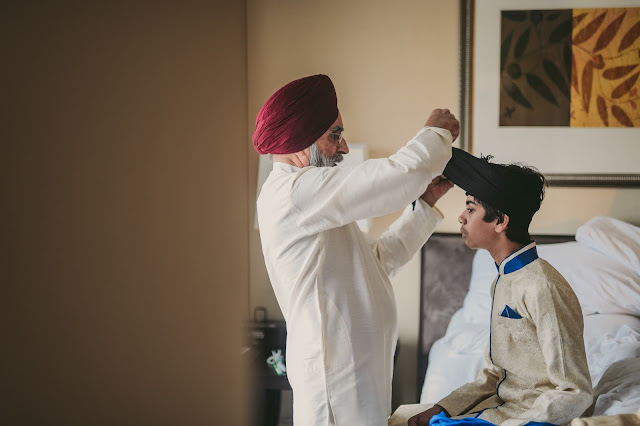The main Sikh wedding ceremony, called the Anand Karaj (or "blissful union") traditionally takes place in the morning, and is finished before noon. As with many things, this had it's pros and cons - on the one hand, we were exhausted from the Sangeet the night before, but on the other hand, jumping right into things meant there was no time for jitters to build (plus, beautiful soft morning light!)
All photos by our amazing photographers; Justin and Lexi of C+I Studios (http://www.c-iphotographers.com/)
Out of respect for the presence of the Guru Granth Sahib (Sikh holy text), we asked our wedding party to cover their heads. For the boys/men, this meant wearing a turban.
Jay's dad tying a turban on our nephew.
I love the below photo of Jay and our nephew, who served as our serbala. The serbala is traditionally a caretaker of the groom and whose responsibility is to keep him safe in the days leading up to the wedding.
Another tradition is the application of the eyeliner, called surma. This is usually performed by the sister or women of the groom's family.
Jay's cousin applying his surma.
This is Jay's wedding headdress, called a sehra.
Traditionally, the sehra is tied on by the sister or women of the family.
Jay's mom and sister getting the sehra ready.
Meanwhile, over in my room, my bridesmaids were pulling petals off of roses for our ceremony.
...and I was still getting my makeup done!
Sikhs are supposed to wear five articles of faith at all times. While this may not be practical (or legal, as you'll see) for every day, it's especially important during ceremonies. One of the five articles is the kirpan, which can be a sword or knife, and symbolizes the characteristics of a saint-soldier.
The saint-soldier is supposed to have control over his own internal vices as well as to constantly be immersed in and embody the virtues written in the holy text. They must also have the courage to defend the rights of all who are wrongfully oppressed or persecuted, irrespective of their color, caste, or creed.
The first "public" part of the wedding ceremony was the procession of the baraat (groom's wedding party) to the milni (location for the meeting of the families.) The procession is celebratory, with singing, dancing, and drums (and cellphone cameras.)
Jay's family arriving at the milni.
My family waiting to greet Jay's family at the milni.
I took a quick break from getting ready to watch the proceedings from my window.
Once everyone is at the milni, each member of the family meets the same member from the other family (i.e. father and father, mother and mother, etc.) In a pretty humorous tradition, they each try to be the first to put a garland around the other's neck, and then pick them up off the ground in a bear hug. Our parents kept it pretty tame and just placed the garlands on each other civilly, followed by a heartfelt hug.
But our siblings took things pretty seriously.
Afterward, there was a prayer.
...meanwhile, I was *still* upstairs getting ready.
Some finishing touches to keep all my (heavy) embroidered fabric and jewelry in place. (Fun sidenote: after the ceremony, it took Jay and I a solid 30 minutes to get all the safety pins, jewelry -- some of which was held in place with eyelash glue, and bobby pins off of me.)

...And back downstairs, guests were starting to arrive and fill the ballroom.















































































